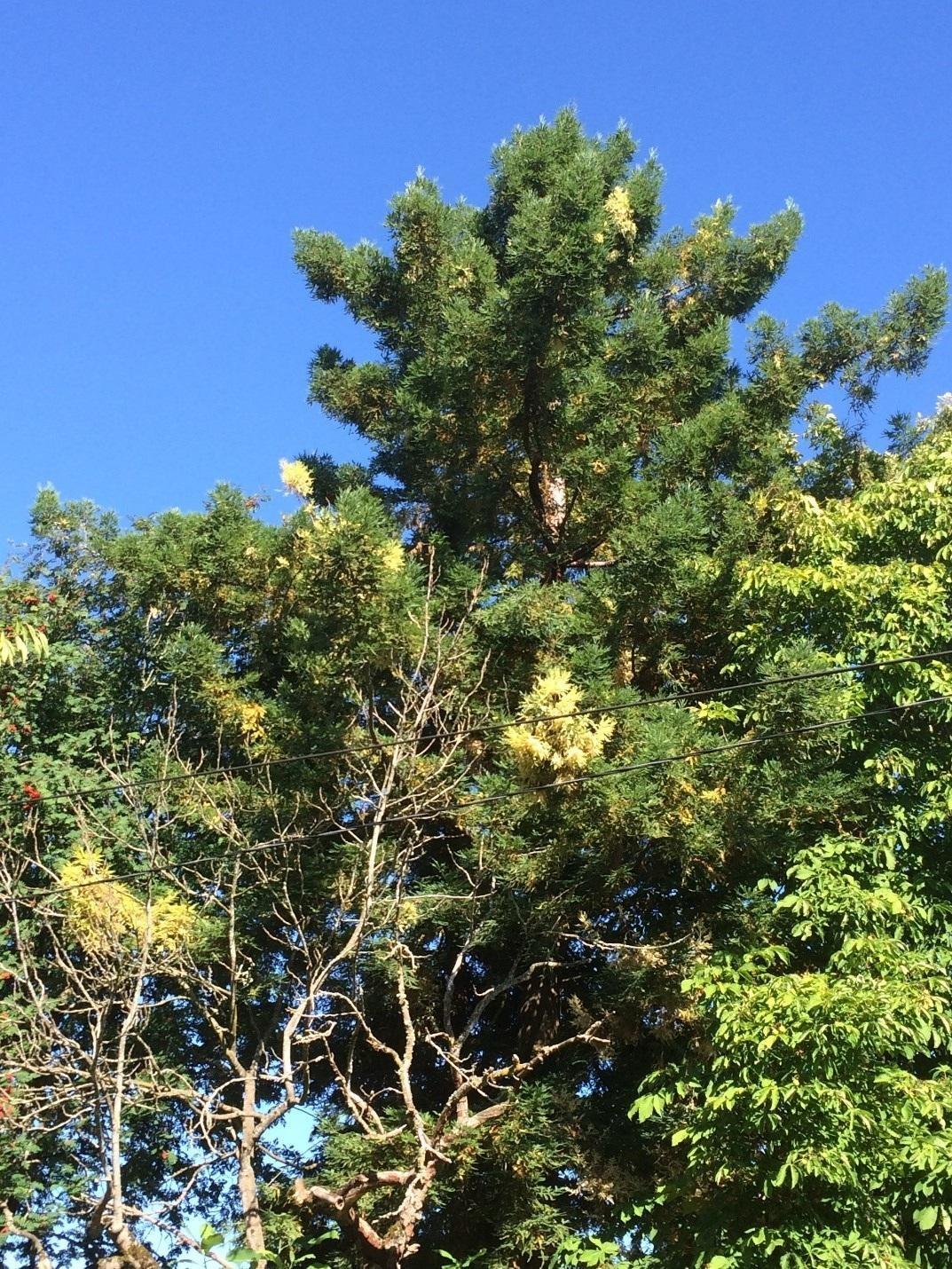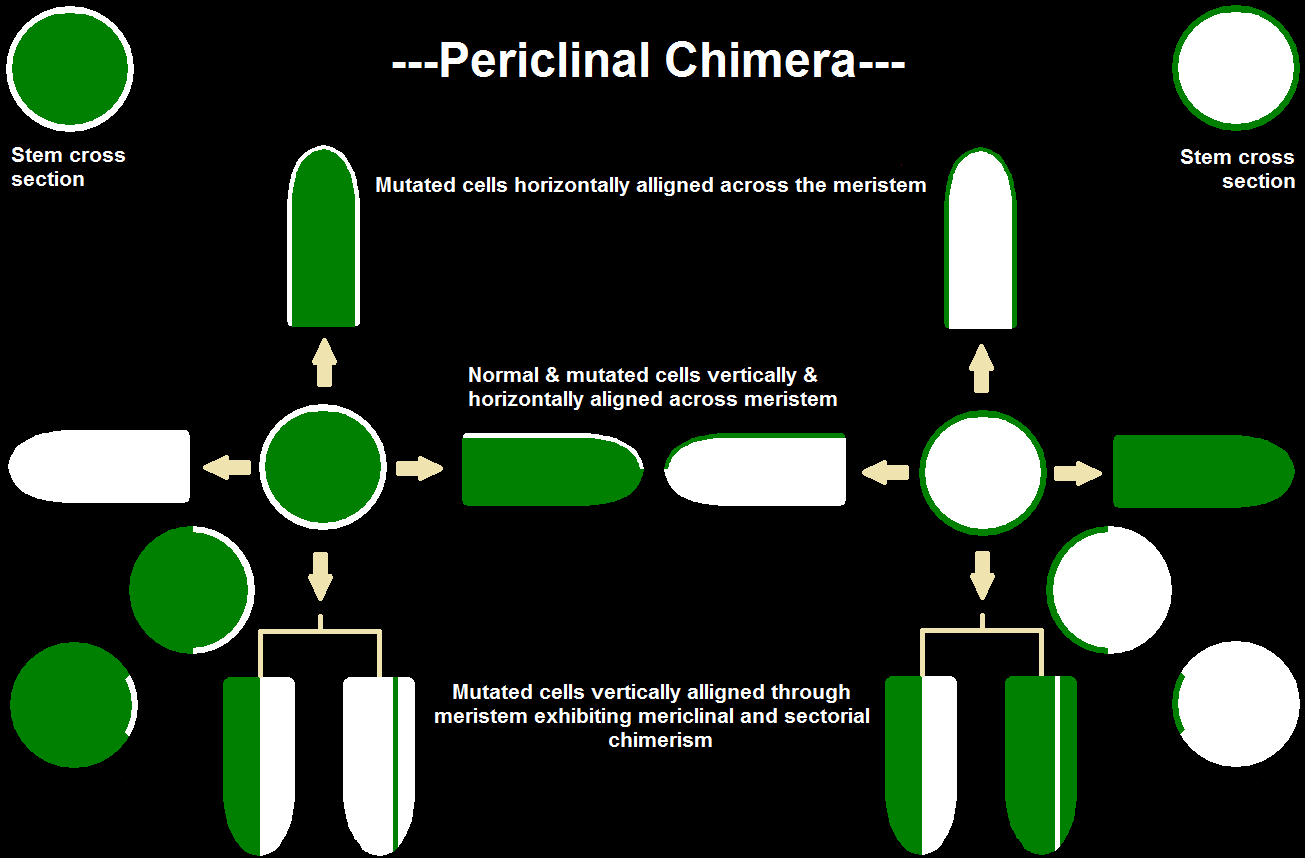Albino redwood scientists consider the Periclinal Chimeric Albino Redwood one of the most intriguing of all redwood mutations. The reason for the attention is that this particular chimeric subset has yielded the most clues on understanding redwood morphology than any other redwood mutations known to date. It comes as no surprise that Periclinal Chimeras are currently at the heart of albino redwood research. What makes them unique is that they have two genetically distinct cell layers horizontally arced across the top of each redwood bud. This configuration otherwise known as a stratified meristem allows both normal green and mutated cells to divide and elongate at equal rates. In other words, as the apical meristem (tree leader) grows vertically, both layers of each genotype grow upward together at the same rate. This leads to a very stable, predictable, & long-lived chimera. As each genetic expression forms, scientists have been able to predict with relative accuracy which genotype is likely to occur next in the tree’s branching habit. The Periclinal color scheme has given scientists a virtual road map of how the inner & outer layers are expressed in Redwoods. Interestingly research has shown that all redwood have two genetically distinct layers which before now couldn’t be seen in genotypes with the same color scheme. Unlike Sectorial Chimeras that appear to be two trees sandwiched together, Periclinal Chimeras are literally one tree hidden inside another.
In these green over white periclinal chimeras, the green genotype is expressed first in new growth. Its only later that we see white axillary and accessory buds start forming from the inner layer.
Despite the stable characteristics of Periclinal Chimeric redwoods, they remain extremely rare in nature. To date, there are only around thirty of these unique Periclinal albino chimeras known to exist in the world. Six of them have grown into full-size trees and are considered 'Grand Chimeras'. The odds of a mutation like this occurring in redwoods are greater than a billion to one!
Below are pictures of the six coast redwood grand chimeras known to date. Each tree is listed in order of discovery:

1. This is the famous Cotati tree which remains the first occurrence seen of a full-size periclinal albino redwood. Standing at a modest 52.5 feet (16m), the tree exhibits some of the best arrays of color seen with these mutations. This tree was planted in the late 1940s as a normal green redwood. It wasn't until the early 1970's that neighbors started noticing golden-yellow foliage show up in the canopy of the tree. Despite its amazingly color, it took scientists another two decades to discover the tree in 1998. The tree was recently relocated in 2014 to make way for a new light rail project. See the 2014 news section for the story on this tree.

2. The second grand chimera to be discovered was the ‘Sac Tree’ which was found in the summer of 2014. For two years it remained as the world’s tallest chimeric albino redwood known until being passed up by tree N#4. This redwood stands in at 82 feet (25m) tall and sports well over 50 mutations. A variegated seedling off this tree can be seen in the 'Projects-Seedling Experiments' section of the website. Chimeric Seedlings

3. A third grand chimera discovery came in July of 2016. What made this discovery intriguing was that the tree was found in the Willamette Valley of Oregon. With three grand chimeras now found in the urban landscape, a pattern is starting to emerge which shows these mutations tend to favor areas of human development. Influence on our local environments may be a strong indicator of what’s causing these mutations to occur. In the picture above, the redwood is partially obscured by another tree in the right foreground. In the future researchers plan on conducting soil analysis at these sites to determine if pollution may be a contributing factor in causing these mutations.

4. An unbelievable fourth grand chimera discovery was made in the fall of 2016. The tree pictured here is known as the Mendocino Giant Chimera Redwood. To date, this is the tallest & largest chimeric albino redwood known living in the natural redwood range. The tree was measured by Zane Moore in June of 2018 and found to be 110 feet tall. Comparable in size to the Sac Tree, this redwood produces while foliage first, then expresses green in secondary growth which is opposite in color arrangement to what we see with the Cotati & the Sac trees. Because of the unique phenotypic arrangement (color scheme), a more thorough examination of the foliage will need to be done to better understand this mutation’s patterns. Interestingly, according to the owner, the tree started exhibiting chimeric growth around the year 1975 which is on par with the age of most grand chimeras this size.

5. In July of 2017 a fifth grand chimera was found. This tree was also the second one to be discovered in Mendocino county which is noteworthy considering how extremely rare these trees are. This tree located outside the natural range and far from the coast is located in an agricultural area. The tree is comparable in height to the other Mendocino chimera & stands 115' tall and has an approximate DBH of 4.75'. There are approximately 30+ mutations throughout the tree and exhibits similarities like those of the SAC tree. Locals in the area report that nitrogen poisoning was a problem in the past due to over-fertilization of the soil. Whether this is the cause of the mutation remains to be seen.

6. A sixth grand chimera was discovered in October of 2018 in Northern Oregon. What’s remarkable about this tree is that it may be the largest and tallest grand chimera known. Discovered and measured by fellow researcher Brad Buttram, the tree’s diameter was found to be 5.1’ with an estimated height of 129’. The tree exhibits a minimum of 15+ albino mutational growths throughout the canopy and is similar to trees #2 & #5. More of the albino growths appear to be in the upper canopy while the ones that are lower down appear larger in size. This latest discovery is also located in an agricultural setting, provides researchers with more intriguing evidence that human-related causes may be the reason why we are seeing these mutations.
Diagram of a Periclinal Chimera:


